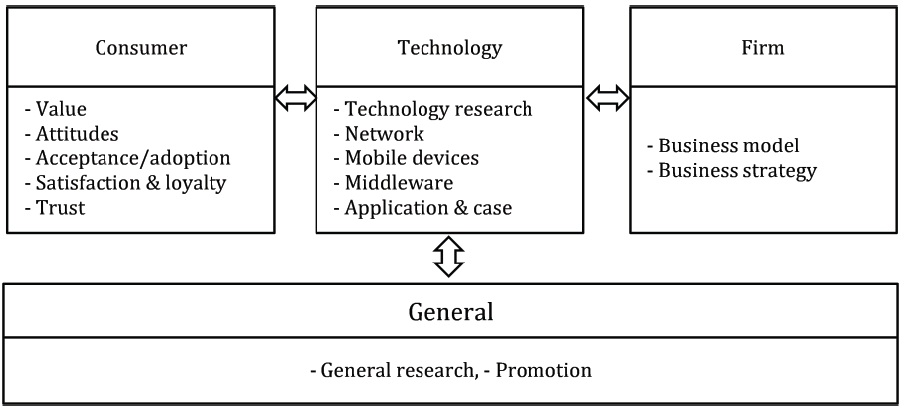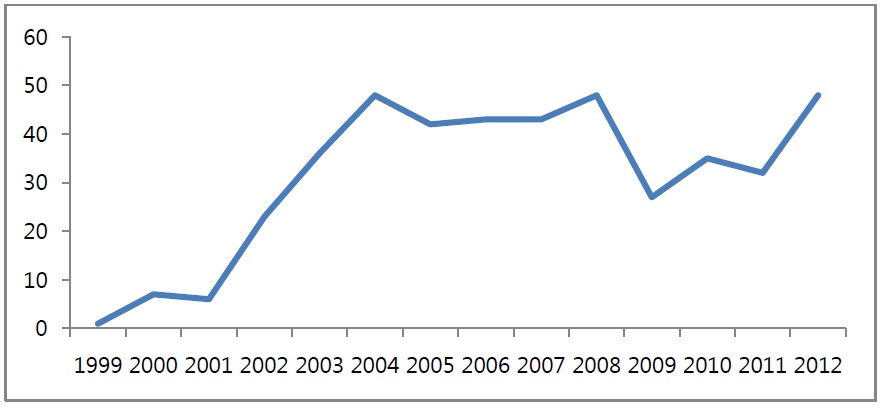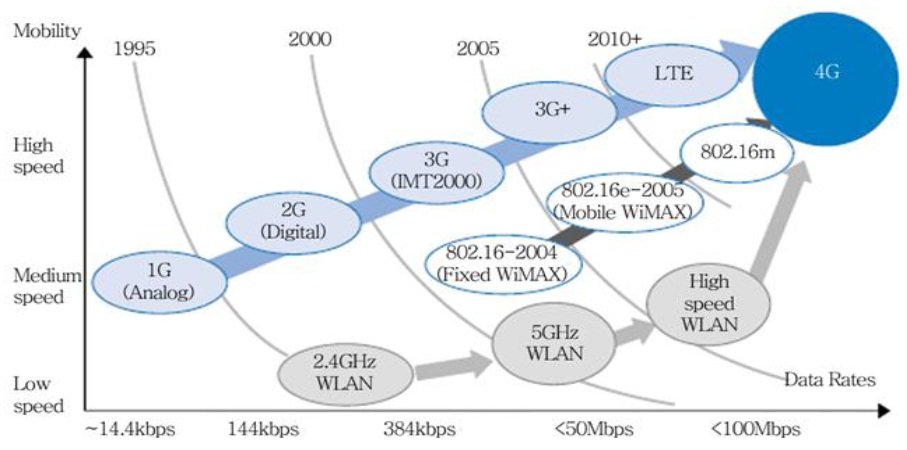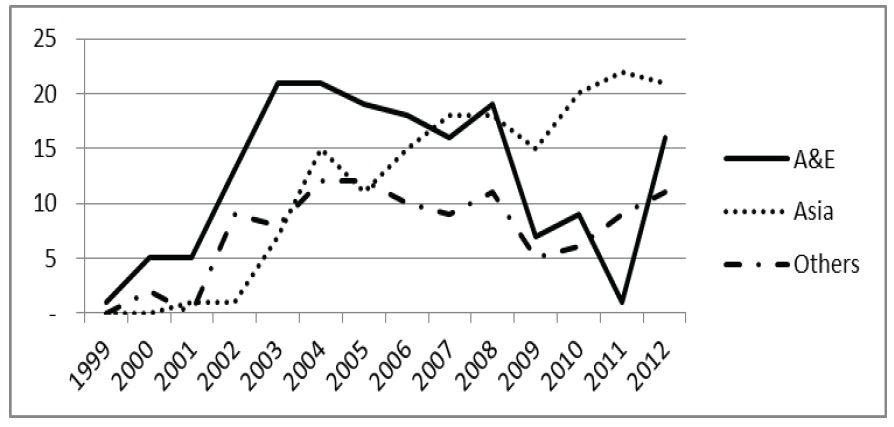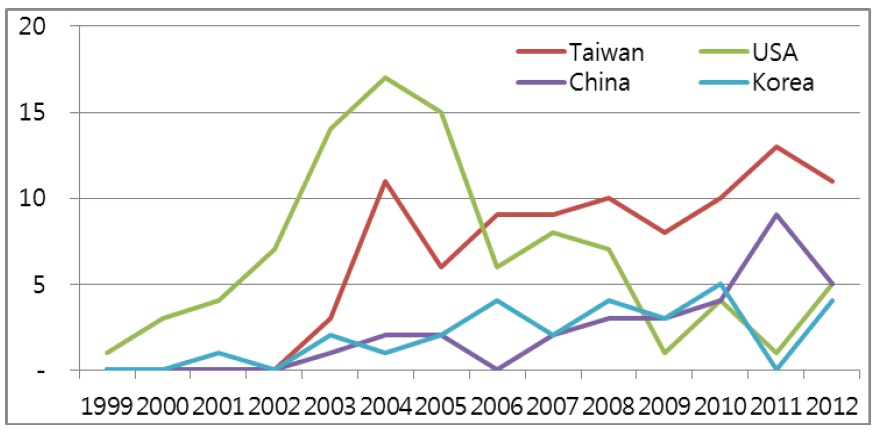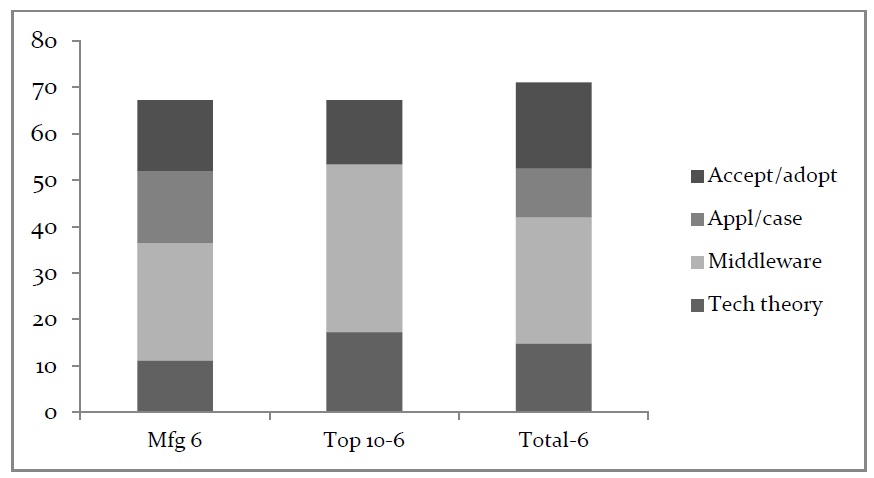



If we search the recent studies in M-commerce or mobile commerce from good academic databases, there are some specific characteristics. First, 10 among 13 articles during 2011-2012 are concentrated on technology aspects (Fuglerud and Dale, 2011; Yang 2011; 2012; Chen and Liu, 2011; Buccafuri and Lax, 2011; Lu, Lee and Tseng, 2012; Chen and Chien, 2012; Yang and Hu, 2012; Oumtrakul et al., 2012; Vives-Guasch et al., 2012). Second, the first authors of 7 out of 13 articles come from Taiwan (Li, Hsieh and Lee, 2011), and 2 from the USA (Khansa, Zobel and Goicochea, 2012; Oumtrakul et al., 2012) and 1 each from 4 countries (Fuglerud and Dale, 2011; Buccafuri and Lax, 2011; Vives-Guasch et al., 2012; Kloch, Petersen and Madsen, 2011).
These facts led us to ponder the full scope and changing patterns of mobile commerce research and its leading countries. There must be many areas of research and also many countries in this discipline. Then, what is the whole scope of mobile commerce? What makes the overall trends? And what countries lead this discipline and why?
This study wants to identify the research trend of mobile commerce and its determinants, which points to leading countries. This is a survey article to answer these questions spanning from the starting year of this field of 1999 to 2012.
To meet this purpose, this study classifies detail categories of mobile commerce following several studies to show the scope and trends of mobile commerce such as Scornavacca, Barness and Huff (2006), Ngai and Gunasekaran (2007) and Kourouthanassis and Giaglis (2012). In addition, some studies showed detailed trends from each topic (Wu et al., 2010; Dahlberg et al., 2008; Varnali and Torker, 2010).
This article checks existing literature introducing the scope and trends of mobile commerce and suggests an analytical framework in section 2 and methods and data in section 3. In section 4, determinants of research and research trends will be analyzed. In section 5, research patterns by countries and by subject will be shown. In section 6, discussion and conclusion will finish this article.
Scornavacca, Barness and Huff (2006) is the 1st paper to review mobile commerce by subject. Meanwhile Ngai and Gunasekaran (2007) reviewed articles on the view of technological application with their own analytical framework. This framework was used in other review papers: Park and Saplan (2011) and Kourouthanassis and Giaglis (2012) both of which aims to show overall trends.
As for review in specific topic, Dahlberg et al. (2008) shows the trends in payment system of mobile commerce with 9 categories from the five-force model (service providers, new e-payment firms, traditional payment firms, consumer power, merchant power) and generic contingency theory (society & culture, commerce, technology and legal/regulatory & standards). Wu et al. (2010) analyzes the trends in consumer behavior with 3 categories such as consumer acceptance, loyalty and continuance. Varnali and Toker (2010) classify the disciplines of mobile marketing into theory, strategy, consumer behavior, law and public policy.
As for review in specific country, Min and Ji (2008) reviews Chinese research on mobile commerce based on the framework of Scornavacca, Barness and Huff (2006), and Ko and Seol (2011) reviews Korean articles.
[Table 1-a] Research framework of existing literature
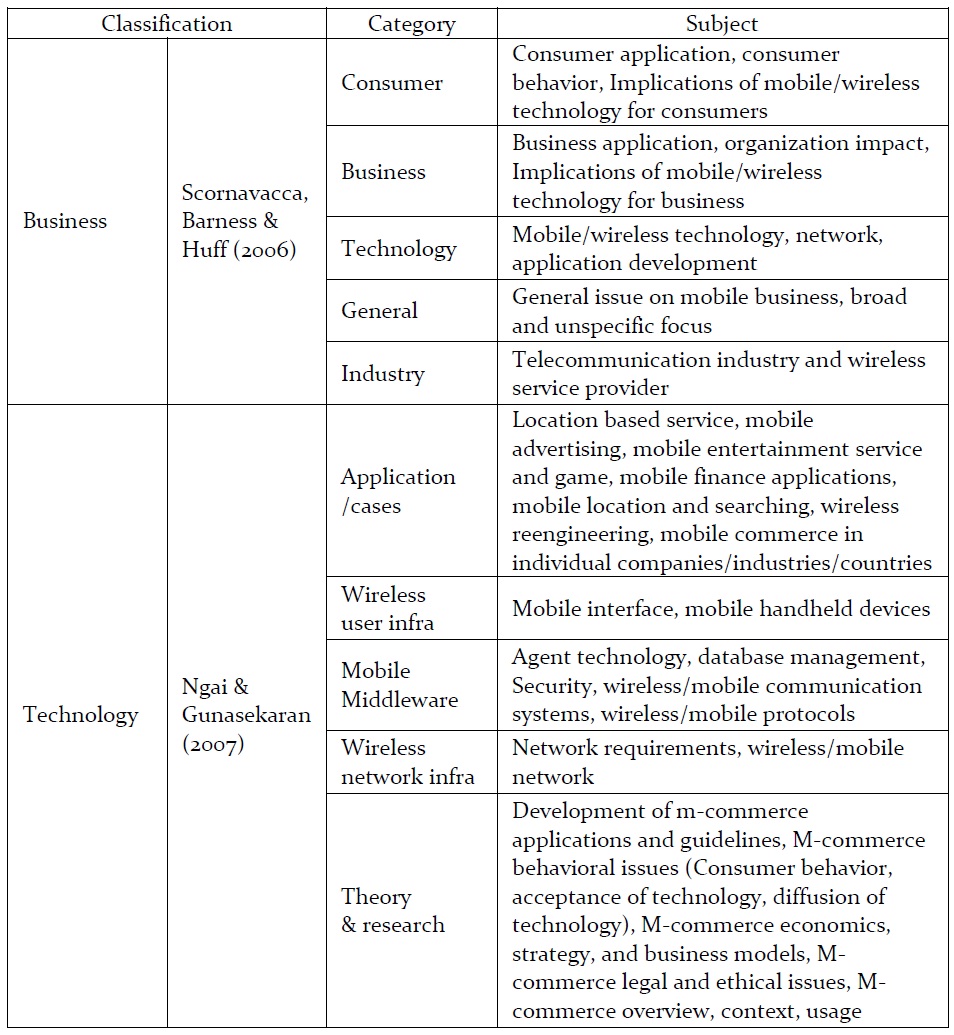
Research framework of existing literature
[Table 1-1b] Research framework of existing literature
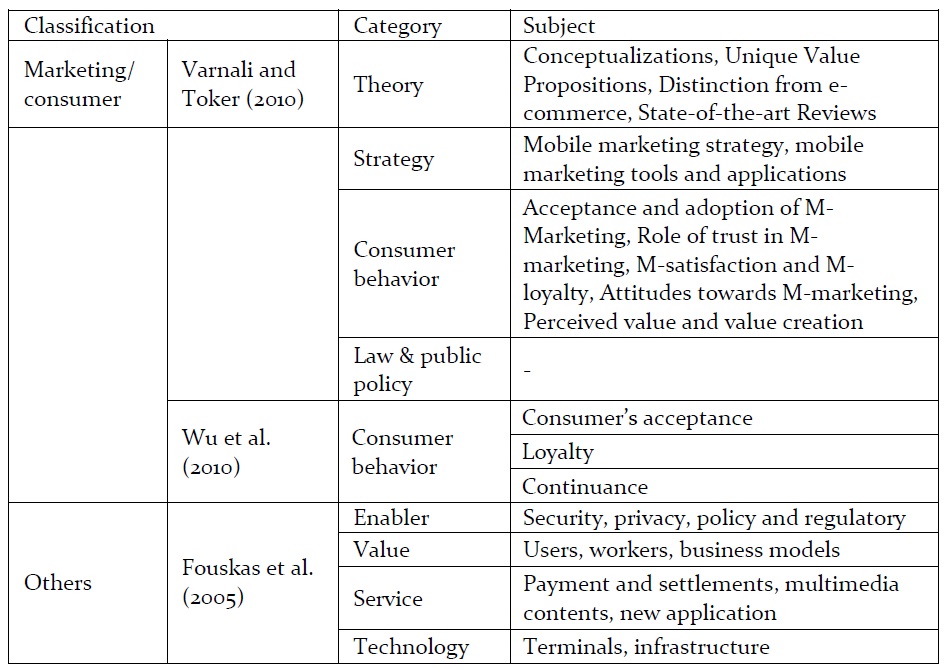
Research framework of existing literature
As for forecast of mobile commerce research, Fouskas et al. (2005) suggests short-term (2004-5), mid-term (2006-8) and long-term (2008-2010) research roadmaps based on classification of mobile business such as success factors, value, service and technology.
Existing reviews on mobile commerce do not show the overall features of mobile commerce through their analytical framework as shown in Table 1, because their targets were different. Scornavacca, Barness and Huff (2006) classify 29 subjects into 5 categories such as consumer, business, technology, general and industry. Ngai and Gunasekaran (2007) also uses 5 categories such as application/cases, wireless user infra, mobile middleware, wireless network infra and theory & research. Although the frameworks of these two reviews are used in another study, the former is for the domain of business, and the latter technology. Even the framework of Ngai and Gunasekaran (2007) adopted that of Varshney and Vetter (2002) on consumer perspective.
Unlike these survey articles, Khansa, Zobel and Goicochea (2012) analyze patents on mobile commerce. They showed focal patent terms and innovation by year from 2001 to 2010. The patents increased from 173 in 2001 to 516 in 2010. The leading company is IBM with 40 patents followed by Microsoft with 32 and Samsung with 26.
The differences between analytical frameworks mean different perspectives on mobile commerce. This article categorizes mobile commerce into 4 domains: general, technology, consumer, and firm as shown in Figure 1. The principle of classification in this article is the independency of each category. This framework seems to that of Scornavacca, Barness & Huff (2006). But, the important difference is that each category of them includes technologies related to the category. In addition, this article puts industry category of them into general category. This may be the whole scope of mobile commerce research without any duplication.
Categories of general are divided into general research and promotion. General research is composed of overview, characteristics, difference with ecommerce, research trends, and legal and policy issues. Promotion is composed of success and failure factors, barriers, market diffusion, and promotion of specific industry.
In technology category, this paper borrowed the classification system of Ngai and Gunasekaran (2007) and reclassified subjects reflecting technological changes as shown in Table 2.
Factors mentioned in consumer category are different from each study. In this category, this article adopts the classification of Varnali and Toker (2010), but changed the terms of some factors.
This paper classified firm category into business model and business strategy considering Ngai and Gunasekaran (2007)’s classification.
[Table 2] Analytical framework
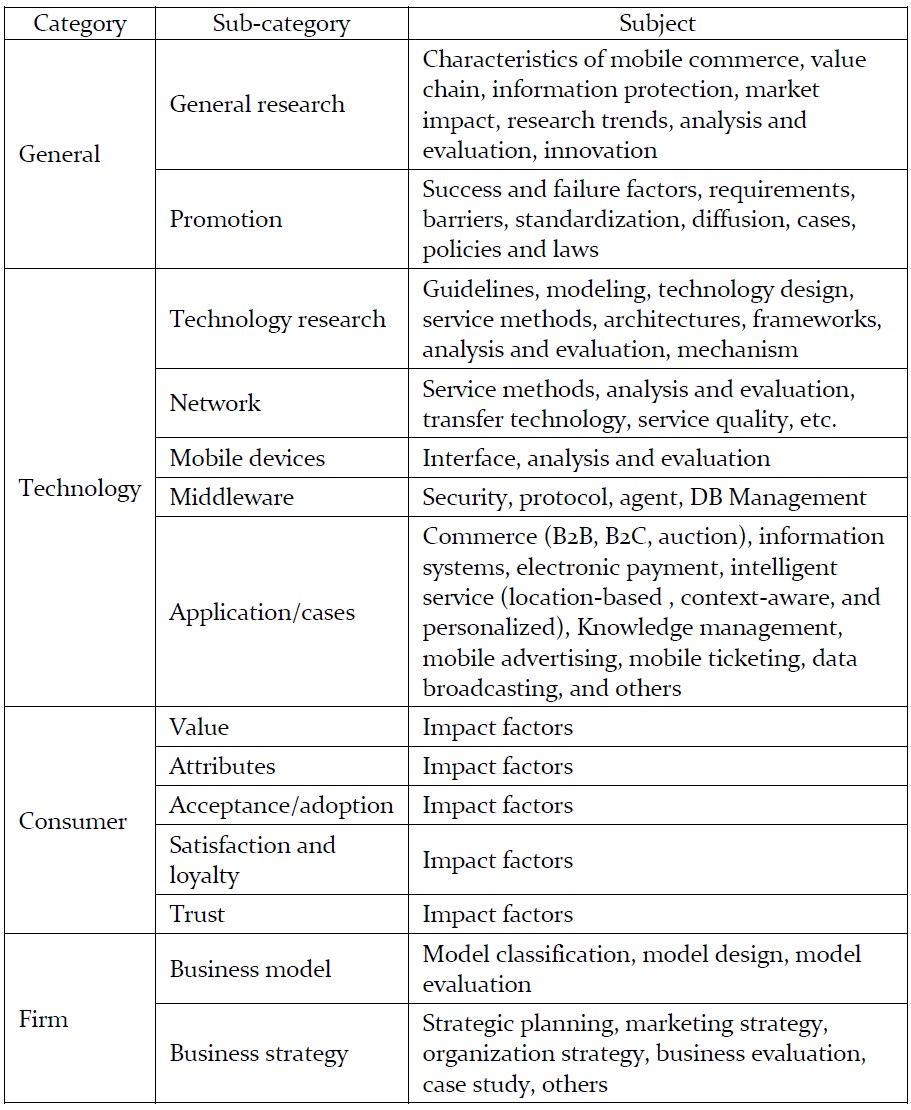
Analytical framework
This article searched the keywords of mobile commerce or m-commerce in articles and summaries during 1999 to 2012 from the journals commonly listed in the SCOPUS and SSCI/SCI database. Search resulted in 785 articles but this article finally decided on 439 articles of which main topics are m-commerce related. In fact, the first step was a search from the SCOPUS database and the result of 1,636 was screened by journals in the SSCI/SCI database.
This article analyzed and classified the title and keywords of each article, and distributed each article to each cell of our analytical framework. In case the title was unclear, abstracts and main text were checked.
Articles on M-commerce have appeared since 1999 as shown in Figure 2. The appearance of articles by year can be divided into 5 stages: from 1999 to 2001, increase during 2002-2003, peak in 2004-2008, decrease in 2009-2011, and increase in 2012.
There are 134 Journals having M-commerce articles, and journals having more than 10 articles numbered 9 with 183 articles. International Journal of Mobile Communications is the first with 62 (14.1%) and followed by 30 (6.8%) in Electronic Commerce Research and Applications (6.8%) and Expert Systems with Applications 18 (4.1%). One characteristic in journals is that no articles are found in the journals that deal with off-line commerce like Journal of Retailing.
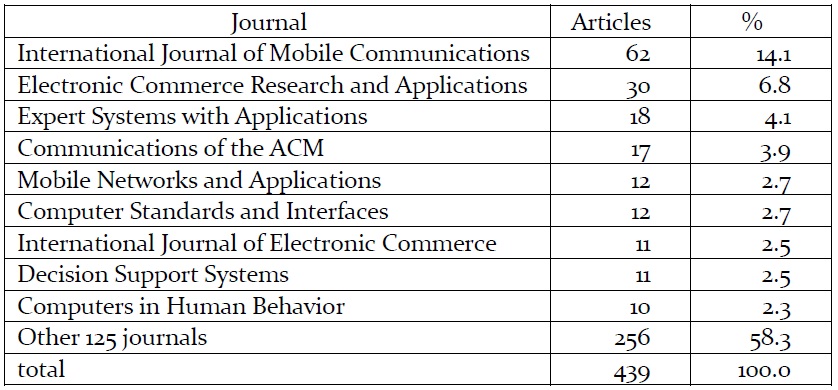
Articles by journal
There were 1,100 total authors who wrote 439 articles from 41 countries, so each article averaged 2.5 authors. Most authors are academics with 89.0%, and authors from research institutes and firm are 5.0% respectively. In addition, 0.9% comes from government and others.
In terms of 1st author, the biggest country the articles came from is USA 21.2%, followed by Taiwan 20.5%, China 7.1% and Korea 6.4% as shown in Table 4. These 4 countries consist of 55% of the total articles. It is interesting that the number of articles from some of the world leading countries such as Japan and France are insignificant.
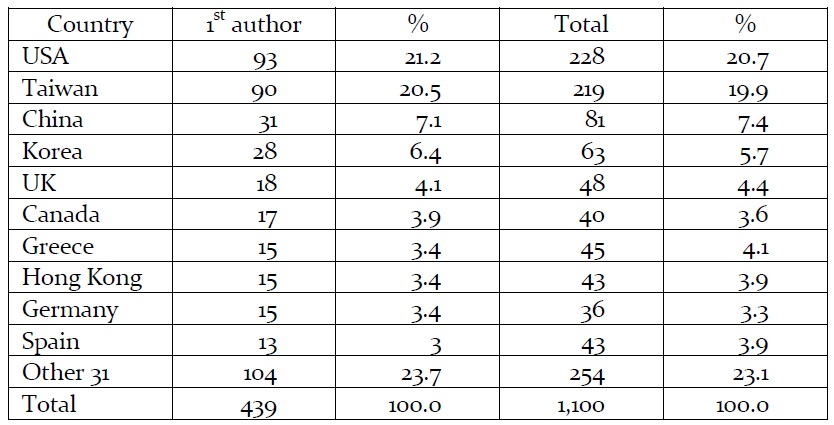
Authors by country
IV. Determinants of Research and Research Patterns
There exist two significant trends. First, the number of articles decreased from 2009, and increased again from 2012. Second, 55% of articles come from 4 countries such as USA, Taiwan, China and Korea. Therefore, we ask two questions from the data. What caused this yearly trend? Second, what is the reason for concentration in specific countries? Besides, we would like to add one more question. What are the hidden patterns by country?
1. Determinants of Yearly Articles
Our simple division of 5 stages in the data section is quite similar to the evolution of mobile technology by stage illustrated by Ahn and Shin (2012). Lets first look at their illustration shown in Figure 3. The 2nd generation digital system (2G) started from 1997 after the 1st generation of analogue. And 3G was introduced in 2002 by the IMT2000 project and 3G+ was introduced in 2004. The 4G, LTE technology has been diffused from 2010.
Technology in mobile devices, not shown in the illustration, has evolved like the mobile communication system. The NOKIA 5110, a famous model of Nokia in 1998 and NOKIA 3310 in 2000 led the market and opened the real hand phone world. Further, iPhone in 2007 and 3G iPhone in 2008 has appeared merging in telecommunication, personal information management and Internet device.
Table 5 is the table converted from the figure 3. In the 1st phase (1999- 2001) of the 2nd generation mobile communication system, only voice and short message service (SMS) were provided. So, little studies on mobile commerce were done to find out business opportunities. In the 2nd (2002-2003) and 3rd (2004-2008) generation mobile communication services, continuously increasing transmission speed widely opened mobile commerce. This fact boosted studies on mobile commerce during this period.
[Table 5] Evolution of mobile technology
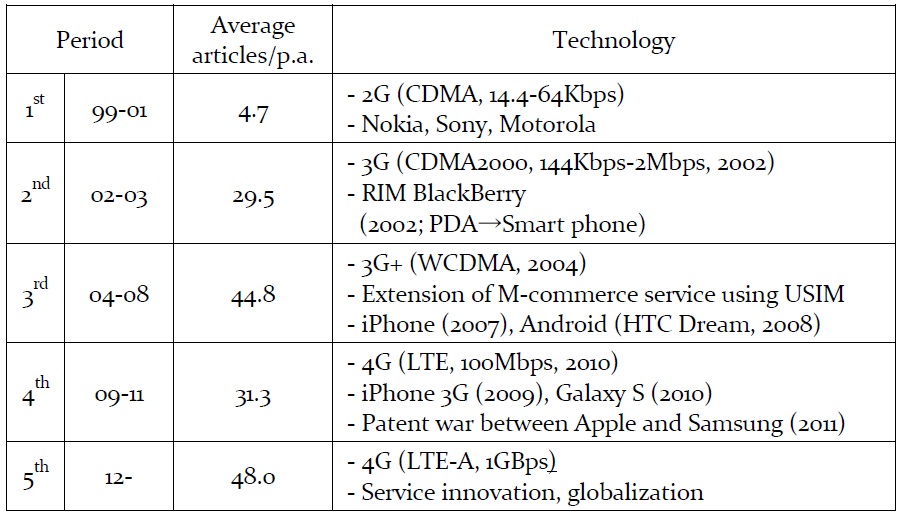
Evolution of mobile technology
Many changes were observed in the 4th phase (2009-2011). Communication service adopted the 4th generation wireless system from 3G+ to 4G LTE (Long Term Evolution), and smart phones such as iPhone 3G and Samsung Galaxy S emerged and replaced feature phones in the device market. Before wide usage of the 4th generation, research articles on mobile commerce decreased in 2009. The change in 2009 may mean that research on mobile commerce was saturated reflecting the development of a real market in mobile commerce, but this trend turned up because of the appearance of new mobile communication and devices. In summary, the number of studies on mobile commerce may come from the changing environment of mobile commerce caused by technology development.
Figure 4 shows a trend in mobile commerce research among the top 10 countries. In the early times, America and Europe lead this discipline, but from around 2007 the number of articles from Asia surpasses those of America and Europe.
The illustration of the top 4 countries makes the trend be more visible. USA led this discipline followed by 3 Asian countries as shown in Figure 5. Articles from Taiwan, however, have led this discipline since 2006 recording an average of 10 per annum. Taiwan’s research started 3 years later, but their effort in this discipline was remarkable considering the country size.
Then, what makes these 4 countries as the leaders in this discipline claiming more than half of all articles? They all have wonderful mobile environments and world leading manufacturing companies for mobile devices. Thus, more research concerns are directed to the launching and operating of mobile business than countries that have no such environments.
In the USA, there are Apple, Motorola and Google. In Taiwan, there is HTC (High Tech Computer Cooperation), which launched the HTC Dream with Google and other manufacturing companies related to mobile devices. In China, Hwawei and ZTE are also world giants in manufacturing. In Korea, Samsung Electronics and LG Electronics are the leaders in mobile devices.
Besides these 4 countries, 2 more countries have manufacturing companies. The United Kingdom ranked 5th with 18 articles and the former Sony Ericsson, one of the leading companies in the 2nd or 3rd generation market was headquartered in London. Canada is 6th with 17 articles and has Research in Motion with its brand Blackberry.
In mobile environments, most countries among the top 10 are well networked and equipped. Some exceptions were found in Spain and Greece. Articles from Spain were unevenly distributed by years, but were concentrated in 2012, in which 7 out of 13 articles appeared. This may be linked to the fact that Spain recorded the highest growth of 70% in mobile commerce in Europe in 2012 (Anonymous, 2012). Articles from Greece were distributed every year with 1-3 since 2000.
V. Research Patterns by Category and Country
In categories, technology category is the largest with 56.9% followed by consumer category of 22.8%, general category of 11.2%, and firm category of 9.1% as shown in Table 6. Technology matters have been the hottest topic in this discipline. If we check the trend, consumer category has been increasing gradually and current trend may be more consumer-oriented.
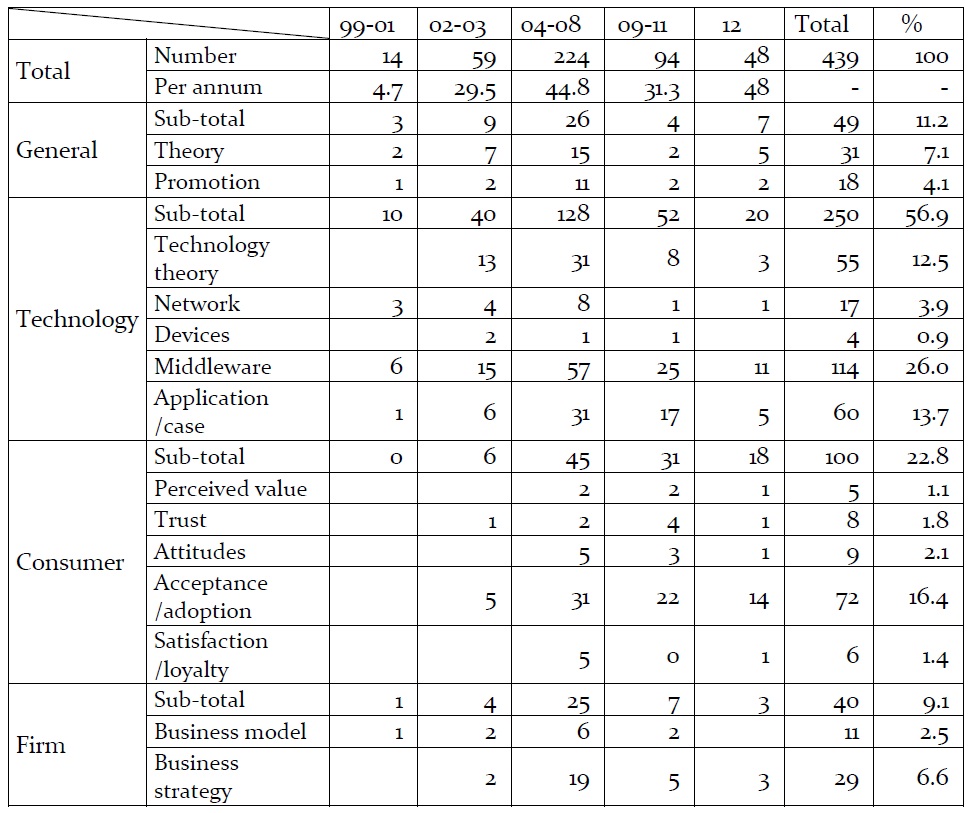
Articles by subject
As for category level, general category started from Curtis and Sinton (1999) of USA and reached a peak in 2012. Articles in technology category are identified in 2000 from several countries: Greece (Gamvroulas, Polemi and Anagnostou), Germany (Hartung and Ramme), and USA (Lu; Brustoloni and Garay; Celik, Datta and Narasimhan), Singapore (Xun et al.) and Portugal (Romao, Silva and Silva). The number has declined unlike other categories since 2005. Consumer category emerged from 2003 with 5 articles in acceptance/ adoption (Hung, Ku and Chan; Jih and Lee; Aoyama; Sarker and Well; Van Akkeren and Harke) and 1 in trust (Siau and Shen). Studies on acceptance and adoption led this category, and 18 cases in 2012 were the most studied. Articles in the firm category appeared from Tsalgatidou and Pitoura (2001), and business strategy is dominant in this category.
2. Research Patterns by Sub-categories and by Groups
The fact that the top 6 countries have manufacturing companies was already mentioned. Therefore, countries can be classified into 4 groups like Table 7. The first group consists of 6, and the 2nd group is the other 4 countries rounding out the top 10. The third and fourth group is classified along with the number of articles, but it is difficult to say any patterns emerge in these countries because they have few articles.

Groups of countries
There is no significant difference in the category level in this grouping, but there are some differences at the sub-category level. Figure 6 shows the difference in the big sub-categories by groups. In total countries, middleware is the hot issue in sub-categories with 26.0%, and acceptance/adoption is the second with 16.4%, Application/case 13.7%, and Technology theory 12.5%. The hottest 4 sub-categories share 68.6% of the total.
The composition of big 4 sub-categories by groups are a little different. The share of total countries except 6 manufacturing countries is a little higher than that of the 6 manufacturing countries. And technology theory, middleware, and acceptance/adoption sub-categories of the total except manufacturing companies are larger than those of the manufacturing countries. The clear distinction is found in the composition of manufacturing countries and nonmanufacturing leading countries. Non-manufacturing leading countries (top 10-6) have no research in application/cases, and the share of middleware is very high.
3. Patterns of Big 4 Countries
Table 8 shows the detail distribution of big 4 countries by subject. Research pattern of the USA is as follows: articles are relatively distributed to 4 categories, and they have a relatively big share in general category and firm category unlike other 3 countries.
The articles in general sub-category and in general category from USA number 12, which appeared in the earlier period. Some of them are information safety (Curtis and Sinton, 1999; Ghosh and Swaminatha, 2001), difference with e-commerce (Venkatesh, Ramesh and Massey, 2003), and importance of application (Kumar, 2004) and mobility (Andrejevic, 2003; Dholakia and Dholakia, 2004). In sub-category of promotion, articles on success factors (Raishinghani, 2001; Jarvenpaa et al., 2003; Gebauer and Shaw, 2004) and failure factors (Bai et al., 2005) are noticeable.
In the category of technology, USA articles are dispersed in diverse subcategories. However, if compared to other 3 countries, they are comparatively concentrated on protocol (Celik, Datta and Narasimhan, 2000; Lee et al., 2003; Varshney, 2005; 2007; 2008; Swallows, Yen and Tarn, 2007) in the middleware sub-category. On the other hand, those of Taiwan are concentrated on security and protocol in the middleware sub-category, and electronic payment in the application sub-category. These 3 sub-categories took more than half of their articles in the technology category. Korea is concentrated in agent (38%) and security (28%) in the middleware sub-category.
In the consumer category, the acceptance/adoption sub-category was the leading area with 72%, and articles from USA were published until 2008, and most of the articles from Taiwan, China and Korea were published since 2009. This may reflect the diffusion of smartphone and m-commerce in these countries. In short, mobile commerce research of each country is a reflection of the technology used to do business in the country, especially in the leading countries.
In firm category, 10 out of 13 articles of the USA appeared during 2003- 2005 (Stafford and Gillenson, 2003; Looney, Jessup and Valacich, 2004, Wang and Wang, 2005; Kumar and Zahn, 2003; Mahatanankoon, Wen and Lim, 2005; Frolick and Chen, 2004; Murtaza and Shah, 2004; Lehrer, 2004; Aungst and Wilson, 2005).
Taiwan’s sub-category is highly focused on 3 sub-categories such as middleware of 28.9% application/cases with 25.6%, and acceptance/adoption with 16.7%. Articles in these 3 sub-categories take 71%.
Korea is similar to Taiwan in categories, but different in sub-categories; Korea is highly concentrated in middleware with 50%, and the second is acceptance/adoption with 14.3%. Both Taiwan and Korea has concentrated on technology in category level, and middleware and acceptance/adoption in subcategory level, but the difference is in sub-category of technology theory in Korea and in application/cases in Taiwan.
[Table 8] Research trends of big 4 countries (%)
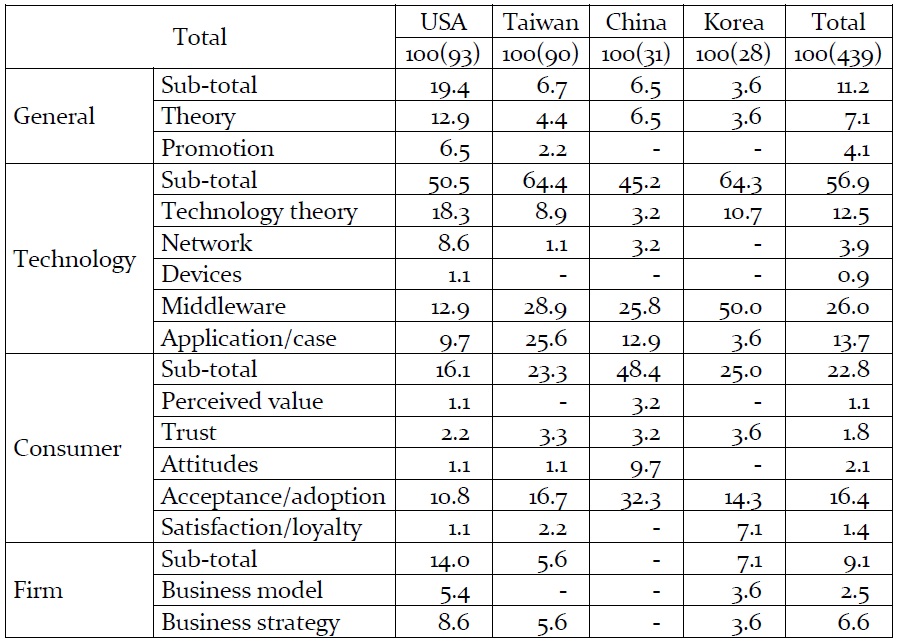
Research trends of big 4 countries (%)
On the other hand, China is highly concentrated in acceptance/adoption with 32.3%, middleware with 25.8%, and application/cases with 12.9% with no articles in firms.
These facts may mean that research in these countries reflect the needs of their countries. In the USA, they had to match device and commerce in the earlier times of M-commerce, and the results are relatively concentrated in protocol. Taiwan, as one of the device manufacturing countries, has had to solve major technological issues for mobile commerce such as security, protocol and electronic payment system. Korea, also a famous device country, is a little different. They are concentrated on areas that especially serve personalized service.
4. Collaboration between Countries
Taiwan, China and Hong Kong share the same language and closely linked markets, so their relationship in articles was checked. Co-works with foreign researchers in the total 439 articles were 16.2% or numbered 71, as shown in Table 9. Most of them are two-country co-works, but 11 articles are 3-country co-works. There were no co-works from more than 3 countries. The first authors from USA, UK and China have 2 3-country co-works respectively, and those from Canada, Germany, Spain and Greece have just 1 3-country co-work. In articles of which first author are from Taiwan and Korea, there is no 3- country co-work.
[Table 9] Co-works between countries
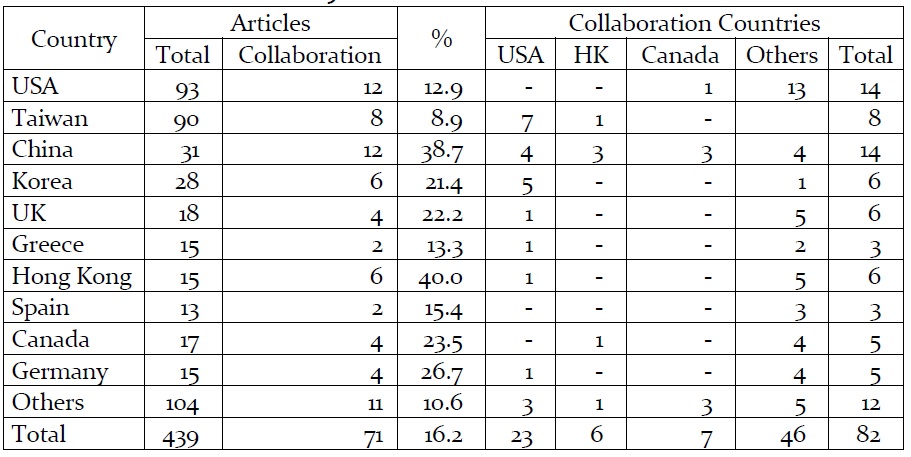
Co-works between countries
Articles from USA were in every category, but other countries were not, although it is not shown in the table. The top 3 countries have no co-works in firm category, and only slight collaboration in the general category by China. Research patterns of Taiwan and Korea are similar; they collaborated with foreign researchers only in the consumer and technology category.
Hong Kong and China was the top in foreign collaboration with 40% and 38.7% respectively, although now two economies become one country. USA is the top country where authors want to co-work, followed by Canada and Hong Kong.
VI. Discussions and Conclusion
This study wants to identify the research trends of mobile commerce and its determinants. The summaries of findings are as follows:
Data
439 articles from 41 countries in 134 journals. Papers are from USA 21.2%, Taiwan 20.5%, China 7.1%, Korea 6.4%, UK 4.1% and Canada 3.9%. These are the countries that have manufacturing companies for mobile devices.
Determinant
The development of mobile commerce research is divided into 5 stages: introduction 1999-2001, increase 2002-2003, peak 2004-2008, decrease 2009-2011, and increase since 2012. The 5 stages are closely linked to the 5-development stage of mobile communication (2G, 3G, 3G+, 4G LTE, LTE-A).
Trends
Technology category is the largest with 56.9% followed by consumer 22.8%, general 11.2%, and firm with 9.1%.
General category started from 1999 and reached peak in 2012.
Technology category was identified in 2000 and declined unlike other categories since 2005.
Firm category started from 2001 and business strategy led this category.
Consumer category emerged from 2003, and acceptance and adoption led this category.
In sub-category, middleware is the hot issue with 26.0%, and acceptance/adoption is the second with 16.4%, application/case 13.7%, and technology theory 12.5%. The hottest 4 sub-categories share 68.6% of the total.
Trends in Groups
USA led the earlier period before 2006, but Taiwan led this discipline after 2006.
Non-manufacturing leading countries have little studies in application/ cases, and the share of middleware is very high.
USA articles are relatively well distributed to 4 categories, and they have a significant share in the general category and firm category unlike other 3 countries, which appeared in the earlier period.
Taiwan is highly focused on middleware with 28.9%, application/cases with 25.6%, and acceptance/adoption with 16.7%.
Korea is highly concentrated in middleware with 50%, and the second is acceptance/adoption with 14.3%. China is concentrated on acceptance/adoption with 32.3%, middleware 25.8%, and application/ cases 12.9%. And, no articles are in the firm category.
Co-works between Countries
Hong Kong and China tops foreign collaboration with 40% and 38.7% respectively.
USA is the top country where authors want to co-work, followed by Canada and Hong Kong.
Implications
It is difficult to predict the future of mobile commerce research, since the very basis of studies on mobile commerce is the evolution of mobile technology and its businesses. However, if we confine our expectation to current technologies, the future keywords are diffusion, innovation and diversity. Diffusion means the spread of mobile business to undeveloped or less developed regions in order to solve technological or service gaps and effectiveness of each service. Innovation means the adoption and fusion of new technologies into businesses such as cloud and RFID technologies to smart phones. This fusion also will lead to diversity of products and research.
Limitation
The limitations of this study may be the article distribution in the analytical framework. An article could go into several cells in our analytical framework, but was stored in only one cell. This allocation may have led to missing important research trends or patterns. Future qualitative works and in-depth reviews are expected to overcome the limits of this study.


